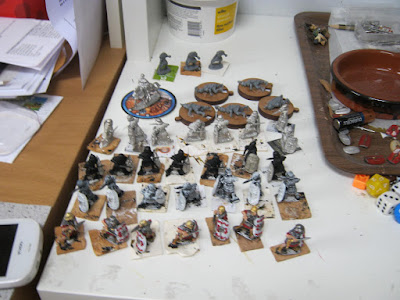Up in Glasgow, Graham and Gordon went to it with figures that could double as a museum of 25mm wargaming - very old school. Some of Gordon's famously ferocious fyrd stood in for gothic infantry, and they did him proud. Gordon's report follows, slightly edited to be a little less rules specific for public consumption.
From the Gothic side the terrain was some rough ground in the left corner and a long open space to a low hill on the right. On the Roman side there was a long ridge facing the Gothic left. The Gothic left was some bow armed skirmishers and two 12-figure light archer units. There then were 5 x 32-figure warbands with a 40-fig in the middle and a 24-fig elite on the right of the line. On the right were 3 x 12 HC 5-6 one of which was elite. The Goths were liberally provided with skirmish archers as well. [All of the warbands and heavy cavalry had an initial Impetus assault capability; a possible disadvantage of this is that it renders them subject to a compulsory charge. Impetuous is a Goth's middle name...]
[Gordon's Gothic cavalry massed behind a hill on their right. It's good to see these guys again - I think the last time they were in action was for the Society of Ancients Battle Day a few years ago for Chalons. That makes them younger than their foot counterparts. These figures are by Musketeer (now Footsore Miniatures) if I remember correctly.]
[Warbands, sir - fasunds of 'em!]
[More of the same, from a different viewpoint.]
The Romans faced the Gothic left with allied light horse and 3 units of Alan and Gothic heavy cavalry. They advanced 24-figure legions onto the ridge and had a couple of legio units to support the cavalry. They were going for a big effort on this side. The Roman centre consisted mainly of auxilia palatina with a further 2 heavy horse. Facing the Gothic left they had a cataphract unit supported by auxiliary light infantry and light cavalry.
[The Roman deployment.]
[A closer photo of the Roman legions and their nice safe hill.]
[And here they are sitting on top of it.]
The Roman plan was to pull the Goths forward perhaps making use of the compulsory charge and fall on them on their left, rolling up the line. The warbands in the centre would be diverted by the auxilia which would be a waste of their strength and the cavalry would hold its own against the Gothic right.
So what went wrong?
The light horse in front of the big Gothic wheel took 4 missile casualties and failed a morale test. The next turn the other LC unit took 3 casualties and failed its test. The traffic jam prevented the Roman flank manoeuvre from developing and the warband advanced en echelon across the table and charged the auxilia. [Units that take too much damage from missiles in a single turn have to test morale; if they fail they must remain stationary for a turn.]
The warbands almost all passed the impetus test and three warbands took out the auxilia in two turns. Everybody on the Roman side failed their morale including the endmost unit on the hill which was then struck by an impetuous war band. [Units that see other massed non-light units rout must test morale; a fail here can be disastrous because it disorders the unit.]
The Gothic right was more conventional. The elite warband got into the cavalry and then the Gothic horse joined in gaining their Impetus. On the first break the Romans all failed their morale again and it was game over.
[The Roman left advances in impressive style. Off to the bottom left of the photo you can just about make out the Gothic heavy cavalry waiting for them.]
Impetus troops are effective and the missile halt rule can decide the outcome.
The only thing that didn't feature was the fates. [This is a special roll to render rout a bit less certain - basically, there is a small chance that a unit will hold on against all the odds. I like to think of it as a loony noble or officer grabbing the standard and rallying enough men to make a last-ditch stand against all the odds.]
[Sounds like a quick battle! It's good to see a battle from later antiquity, certainly several centuries away from where we currently are with the campaign. Thanks to Gordon for the report and photos]

















.jpg)






















.jpg)







.jpeg)













.jpg)

























































































